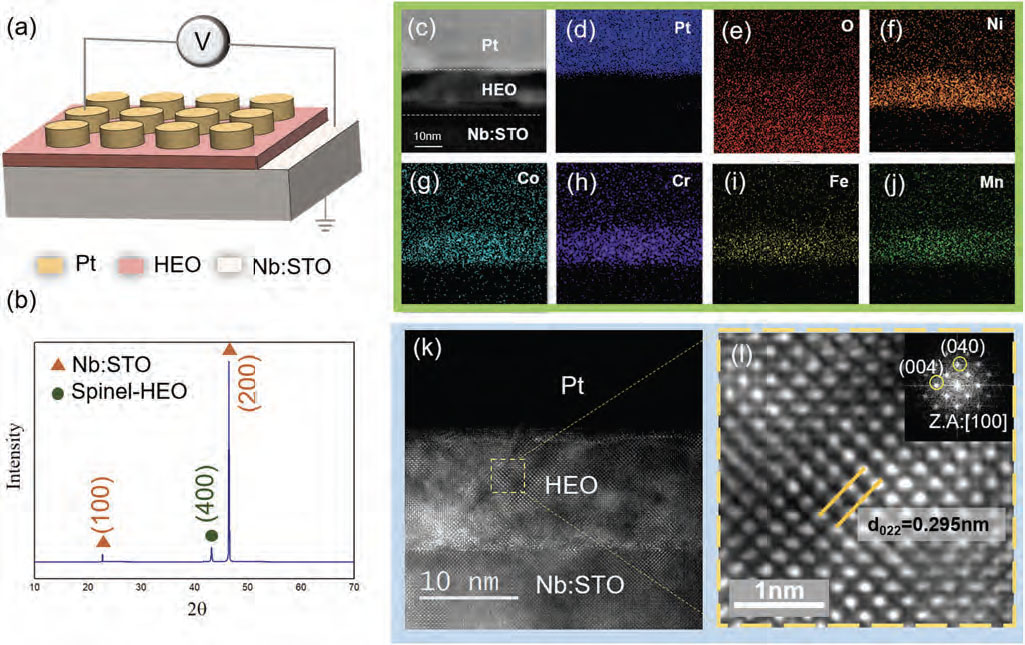| Oct 18, 2023 | |
Advancing memory devices with high-entropy oxides |
|
| (Nanowerk Spotlight) With the exponentially growing data demands of artificial intelligence, cloud computing, the Internet of Things and other emerging technologies, the need for advanced computer memory continues to intensify. Researchers in Taiwan have developed a promising new resistive random access memory (RRAM) material using high-entropy oxides that could enable significant improvements in memory performance and longevity. | |
| RRAM is an emerging memory technology along with memristors that stores data by changing the electrical resistance rather than electronic charge. Compared to conventional memory devices, RRAM offers advantages like faster switching, higher density and better scalability. The new high-entropy oxide material developed by the researchers aims to further improve RRAM characteristics and competitiveness with other next-generation memories like memristors. | |
| In a study published in Advanced Materials ("A High-Entropy-Oxides-Based Memristor: Outstanding Resistive Switching Performance and Mechanisms in Atomic Structural Evolution"), the scientists created RRAM devices with a high-entropy oxide made of five transition metal oxides– chromium, manganese, iron, cobalt and nickel. | |
| Compared to existing RRAM made from common metal oxides, the high-entropy oxide devices showed superior performance in their ability to switch between high and low electrical resistance states to store data. They achieved an ultra-high ON/OFF ratio above 100,000, meaning the two resistance levels were very distinct and far apart to enable clear binary 1s and 0s. | |
| The devices also demonstrated remarkable endurance, maintaining this resistive switching behavior through over 4,500 cycles. Additionally, they could retain data without loss for over 10,000 seconds at room temperature before a reset. | |
| In short, the high-entropy oxide enabled much more robust and reliable resistive switching characteristics compared to conventional RRAM materials. | |
| The researchers attribute these exceptional properties to the unique entropy-stabilized structure of the multicomponent high-entropy oxide. By tuning the composition, the material structure can flexibly transition between a spinel phase and a more conductive rocksalt phase in response to electrical inputs. This reversible transformation enables the resistive switching behavior that allows data storage. | |
| Using advanced spectroscopy and microscopy techniques, the team provided insights into the nanoscale mechanisms underlying this transformation. Applying a positive voltage causes oxygen ions to migrate, inducing localized structural changes from spinel to rocksalt which produce conductivity filaments and a low resistance state. Reversing the voltage causes oxygen ions to return, transforming sections of rocksalt back into the higher resistance spinel structure. | |
 |
|
| Illustration, structure, and compositional identification of pristine high-entropy oxide (HEO) RRAM device. a) Schematic illustration of the Pt/HEO/Nb:STO RRAM device. b) XRD pattern of spinel-HEO and STO. c) STEM image and d–j) Pt, O, Ni, Co, Cr, Fe elemental EDS maps. k) Cross-sectional TEM image and l) HRTEM image and diffraction pattern for HEO. (Reprinted with permission by Wiley-VCH Verlag) | |
| Notably, the different metal cations have varied tendencies to change oxidation state, which prevents permanent filament formation and enables the remarkable endurance. For instance, chromium readily oxidizes back from Cr2+ to Cr3+ to reset the device, while manganese resists reverting from Mn2+ and contributes to the stability. This mixed-valence chemistry balanced with entropy stabilization gives the high-entropy oxide its ideal switching properties. | |
| Compared to binary metal oxide RRAM, the researchers believe the easily tunable composition and structure of these high-entropy materials makes them better suited for optimizing resistive switching behavior. Since conventional silicon-based memories are nearing fundamental limits, new materials like high-entropy oxides will be essential for meeting the memory demands of future electronics. | |
| This discovery provides an important framework for designing next-generation memories with improved performance, efficiency and reliability using entropy engineering principles. While further research is still required, the Taiwan team’s high-entropy oxide RRAM demonstrates the significant potential of these materials for mitigating memory loss in technologies ranging from mobile devices to data centers. | |
| More broadly, this work highlights how high-entropy compounds are an emerging class of materials offering exceptional stability for advanced engineering applications. As our digital infrastructure continues rapid growth, innovations like resistive memory with high-entropy oxides will help ensure the underlying devices can keep pace with our data-driven world. | |
 By
Michael
Berger
– Michael is author of three books by the Royal Society of Chemistry:
Nano-Society: Pushing the Boundaries of Technology,
Nanotechnology: The Future is Tiny, and
Nanoengineering: The Skills and Tools Making Technology Invisible
Copyright ©
Nanowerk LLC
By
Michael
Berger
– Michael is author of three books by the Royal Society of Chemistry:
Nano-Society: Pushing the Boundaries of Technology,
Nanotechnology: The Future is Tiny, and
Nanoengineering: The Skills and Tools Making Technology Invisible
Copyright ©
Nanowerk LLC
|
|
|
Become a Spotlight guest author! Join our large and growing group of guest contributors. Have you just published a scientific paper or have other exciting developments to share with the nanotechnology community? Here is how to publish on nanowerk.com. |
|
